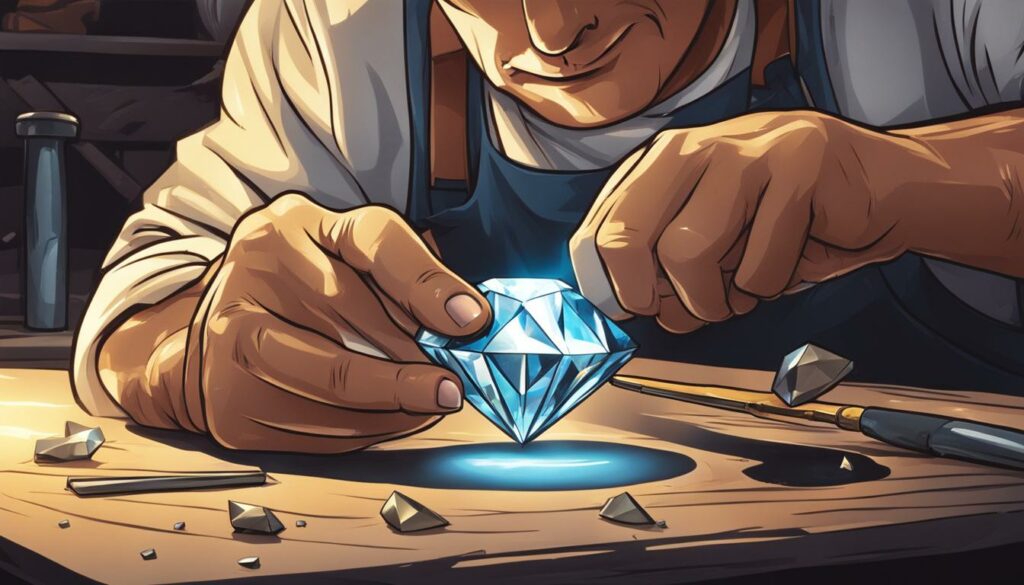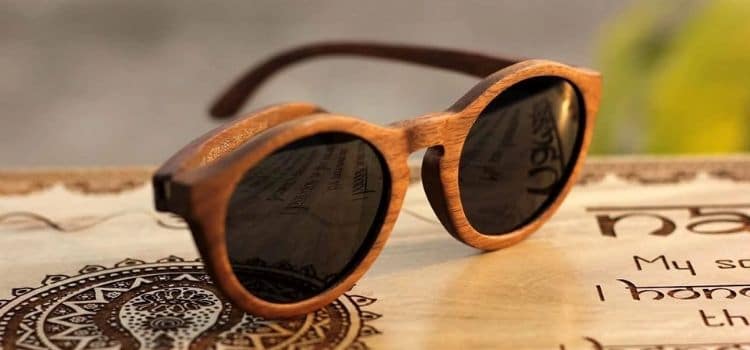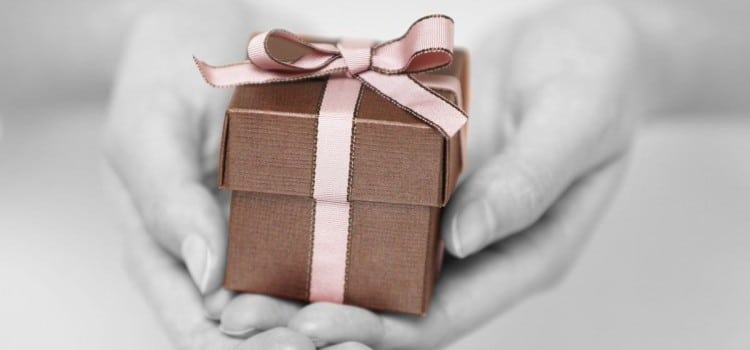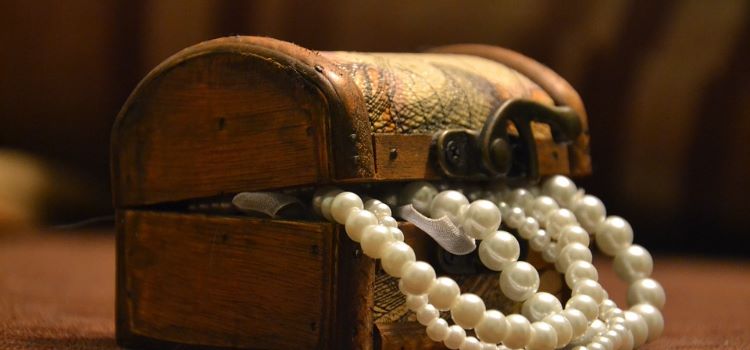Is your precious diamond chipped and in need of repair? Don’t worry, I’m here to help. As an expert in the field, I’ve gathered valuable tips and advice on restoring your chipped diamond to its former glory.
Diamonds, known for their hardness, are generally resistant to major damage. However, over time, they can still develop chips and minor scratches. Rest assured, proper care and the right repair techniques can revive your diamond’s beauty.
Regular cleaning and inspection are essential to detect any issues that require attention. By keeping an eye on your diamond, you can catch chips early on and avoid further damage.
For minor chips and surface scratches, repolishing can be a suitable option. This process removes imperfections and restores the mirror-like finish of your diamond. It’s a great way to enhance its visual appeal without compromising its carat weight.
In cases where the chip is more significant, minor recutting can be considered. By removing a small amount of material, the chip can be repaired, restoring both the clarity and the overall appearance of the diamond.
When deciding whether to repair or replace your chipped diamond, several factors should be considered. The size and value of the diamond, as well as its sentimental significance, play a role in the decision-making process.
Additionally, it’s important to review your insurance coverage. Some policies may offer replacement options for damaged diamonds, which could be a viable solution depending on the circumstances.
In the end, repairing your chipped diamond is not only about restoring its physical beauty but also preserving its sentimental value. Diamonds hold immense meaning for many of us, and repairing them allows us to continue cherishing their significance.
Stay tuned for the upcoming sections where I’ll delve deeper into the factors to consider when repairing your chipped diamond, the different repair options available, and the importance of sentimental value in the decision-making process.
Factors to Consider When Repairing Your Chipped Diamond
When deciding whether to repair a chipped diamond, there are several factors to consider. One important consideration is the size of the diamond and the potential carat weight loss during the repair process. Repolishing is a suitable option for minor surface scratches, as it can restore the diamond’s mirror finish without significant loss of carat weight. On the other hand, recutting is a more appropriate solution for larger chips, although it may result in a slight loss of carat weight.
The decision to repair a chipped diamond should also take into account the sentimental value attached to the stone. Diamonds often hold sentimental significance, especially when they are inherited or given as gifts. Repairing a chipped diamond can help preserve the sentiment and emotional connection associated with the stone. However, it’s important to review your insurance coverage to determine if a replacement stone is a better option.
Ultimately, the decision to repair or replace a chipped diamond should be based on the value and sentiment attached to the stone. While insurance coverage and cost considerations are important, personal preferences and subjective beauty also play a significant role in the decision-making process. Consulting with diamond experts and assessing all the available options can help you make an informed decision that aligns with your needs and preferences.
Table: Factors to Consider When Repairing a Chipped Diamond
| Factors | Considerations |
|---|---|
| Size of the diamond | Smaller chips may be suitable for repolishing, while larger chips may require recutting. |
| Potential carat weight loss | Recutting may result in a slight loss of carat weight, which should be taken into account. |
| Sentimental value | Consider the emotional significance attached to the diamond when making a decision. |
| Insurance coverage | Review your insurance policy to determine if a replacement stone is covered. |
| Value and sentiment of the diamond | Ultimately, the decision should be based on the overall value and sentiment attached to the stone. |
Repolishing and Minor Recutting for Chipped Diamonds
Repolishing and minor recutting are two effective methods for repairing chipped diamonds and restoring their visual appeal. When a diamond suffers minor damage, such as surface scratches or small chips, repolishing can be used to remove these imperfections and restore the diamond’s mirror-like finish. This process involves removing a very thin layer from the diamond’s surface to eliminate any scratches or minor chips. Repolishing is suitable for diamonds with minimal damage, and it has minimal impact on the diamond’s carat weight.
Minor recutting, on the other hand, is a more involved process that addresses moderate to severe chipping. This method involves removing a small amount of material from the diamond to fix the chip and restore the diamond’s clarity and visual appeal. While minor recutting can improve the diamond’s appearance, it may result in a slight loss of carat weight.
I recently had a valuable diamond that had a small chip on the surface. I consulted with a diamond expert who recommended repolishing the diamond to remove the chip and restore its brilliance. The repolishing process was quick, and the diamond looked as good as new. I highly recommend considering repolishing as an option for repairing chipped diamonds.
Repolishing and Minor Recutting Comparison
To better understand the differences between repolishing and minor recutting, let’s take a look at a comparison table:
| Method | Pros | Cons |
|---|---|---|
| Repolishing | – Removes surface scratches – Restores mirror-like finish – Minimal impact on carat weight |
– Suitable for minor damage only |
| Minor Recutting | – Fixes moderate to severe chips – Restores clarity and visual appeal |
– May result in a slight loss of carat weight |
As shown in the table, repolishing is a less invasive method that is suitable for minor damage, while minor recutting is more appropriate for moderate to severe chipping. The choice between the two methods depends on the extent of the damage and the desired outcome. Consulting with a diamond expert can help determine the best course of action for repairing a chipped diamond.
The Importance of Sentimental Value in Repairing Chipped Diamonds
When it comes to repairing chipped diamonds, sentimental value plays a significant role in the decision-making process. Diamonds often carry emotional significance, especially when they are inherited or given as cherished gifts. The sentimental value attached to a diamond can outweigh the cost of repair or replacement, making it worth considering to preserve the sentiment and meaning behind the stone.
Repairing a chipped diamond can provide an opportunity to restore its original beauty and ensure it can continue to be cherished for generations to come. Vintage diamond cuts, for example, can be given new life through expert recutting, allowing the diamond to maintain its sentimental value while enhancing its visual brilliance.
Inherited diamonds are often considered ideal candidates for repair due to the strong emotional connection they hold. By repairing a chipped diamond, you can not only restore its appearance but also preserve its history and the memories associated with it.
| Benefits of Repairing Chipped Diamonds for Sentimental Value |
|---|
| Preserves the sentimental value attached to the diamond |
| Restores the original beauty of the diamond |
| Allows the diamond to continue to be cherished for generations |
| Preserves the history and memories associated with inherited diamonds |
If a diamond cannot be efficiently repaired, an alternative option is to reset it in a pendant or bezel setting. This can help protect the diamond from further damage while still allowing it to be worn and appreciated.
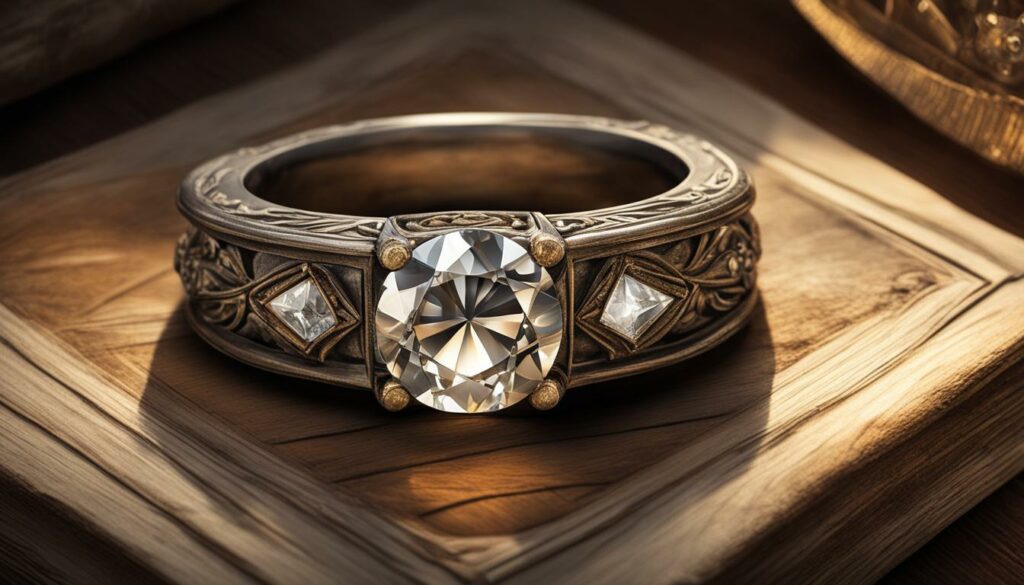
Repairing a chipped diamond not only restores its visual appeal but also preserves the sentimental value attached to the stone.
Understanding Insurance Coverage for Chipped Diamonds
When it comes to repairing chipped diamonds, it’s important to consider your insurance coverage. Many insurance policies provide coverage for damaged diamonds, including chipped ones. It’s essential to review the terms and conditions of your policy to understand the extent of coverage for repairing or replacing a damaged diamond.
Some policies may offer a replacement stone if your diamond is chipped beyond repair. This can be a practical option if the damage is severe or the cost of repair outweighs the value of the diamond. However, if your chipped diamond holds sentimental value or is of significant worth, repairing it may be the preferred choice.
Before making a decision, it’s crucial to assess the sentimental value and financial implications of repairing or replacing a chipped diamond. Take into account the potential loss of clarity or appeal that may come with a repair, as well as the cost of replacement. Consulting with a diamond expert or jeweler can provide valuable insight to help you make an informed choice.
| Insurance Coverage for Chipped Diamonds | Repair | Replace |
|---|---|---|
| Coverage | Some insurance policies offer coverage for the repair of chipped diamonds. | Insurance policies may provide a replacement stone if the diamond is chipped beyond repair. |
| Sentimental Value | Repairing a diamond can preserve its sentimental value. | Replacing a chipped diamond may result in the loss of sentimental value. |
| Financial Implications | The cost of repair should be considered, especially if it outweighs the value of the diamond. | Replacing a chipped diamond can be a more cost-effective option in some cases. |
When assessing insurance coverage for chipped diamonds, it’s important to understand the terms and conditions of your policy. Consider the sentimental value, financial implications, and potential loss in clarity or appeal before deciding whether to repair or replace a chipped diamond. By weighing these factors, you can make an informed decision that best suits your needs and preferences.
The Value of Repairing a Chipped Diamond
When faced with a chipped diamond, the question of whether to repair or replace it arises. As an experienced diamond specialist, I believe that repairing a chipped diamond holds significant value. Diamonds are more than just precious gemstones; they hold sentimental and emotional meanings that cannot be easily replaced. By opting for repair, you can preserve the value and sentiment attached to the diamond.
Repairing a chipped diamond allows you to rediscover its full potential. Expert repairs, such as repolishing and minor recutting, can restore the diamond’s aesthetic appeal and brilliance. By choosing repair over replacement, you give your diamond a second chance to shine and be enjoyed for years to come.
Moreover, repairing a chipped diamond can also save you money in comparison to replacing it. Major recuts or repairs can be costly, especially for larger and more valuable diamonds. By opting for repair, you can retain the value of your diamond without the need for a significant investment. Additionally, reputable diamond retailers often offer the option to upgrade your diamond in the future, allowing you to enjoy both quality and beauty.
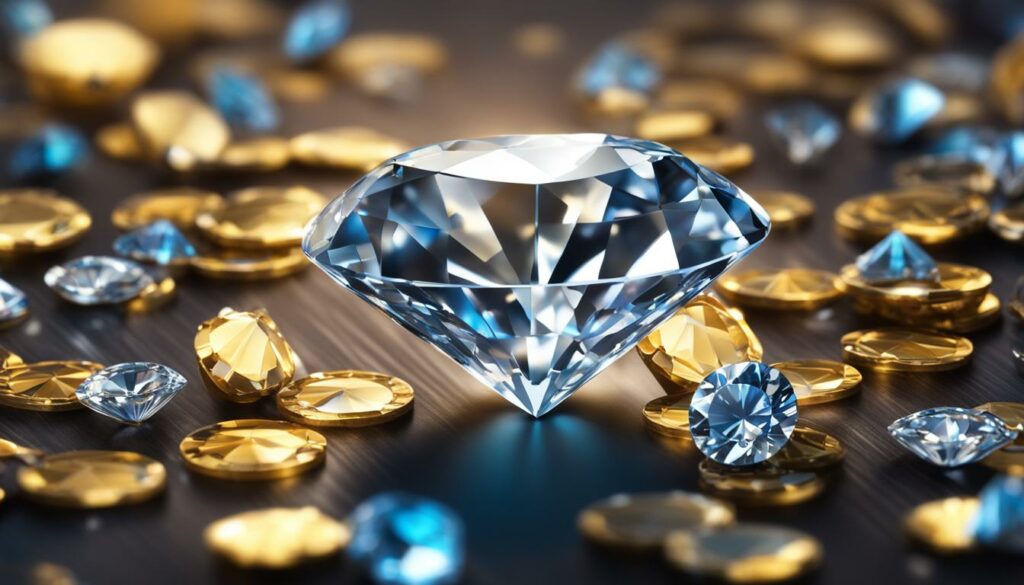
Repairing vs. Replacing Diamond
When considering whether to repair or replace a chipped diamond, it is essential to evaluate the overall value and sentiment attached to the stone. While replacing a diamond might seem like a fresh start, it may not always be the most economical or meaningful choice. The sentimental value and emotional attachment to a diamond often outweigh material considerations.
| Repairing a Chipped Diamond | Replacing a Chipped Diamond |
|---|---|
| Preserves sentimental value | Loss of sentimental value |
| Restores aesthetic appeal | New stone may not have the same visual appeal |
| Economically viable | May be more costly, especially for larger diamonds |
| Retains the original diamond’s history and story | Loss of the original diamond’s story and significance |
Ultimately, the decision to repair or replace a chipped diamond should be based on a combination of factors, including sentimental value, cost, and the potential loss in clarity or appeal. Consulting with diamond experts can help you make an informed decision and ensure that your diamond receives the care it deserves.
Diamond Chips vs. Chipped Diamonds: Understanding the Difference
When it comes to diamonds, there can be some confusion between diamond chips and chipped diamonds. While they may sound similar, they are actually quite different. Diamond chips refer to small diamonds that are often used as accent stones in jewelry. These chips are intentionally cut small and are not damaged diamonds. On the other hand, chipped diamonds are diamonds that have been damaged or have chips on their surface.
Understanding the difference between diamond chips and chipped diamonds is important when discussing repair options. Diamond chips are typically used to enhance the overall design and sparkle of jewelry, while chipped diamonds require repair or restoration to remove the damage. So, if you have a chipped diamond, it means that the diamond itself has sustained some form of damage and needs attention to restore its beauty.
“Diamond chips are intentionally cut small, while chipped diamonds require repair or restoration to remove the damage.”
When it comes to repairing a chipped diamond, it is important to consult with a professional who specializes in diamond repair. They have the expertise and knowledge to assess the extent of the damage and recommend the appropriate repair techniques. Depending on the severity of the chip, options may include repolishing or minor recutting to restore the diamond’s appearance.
By understanding the difference between diamond chips and chipped diamonds, you can better navigate the world of diamond repair and make informed decisions when it comes to restoring the beauty of your precious gem.
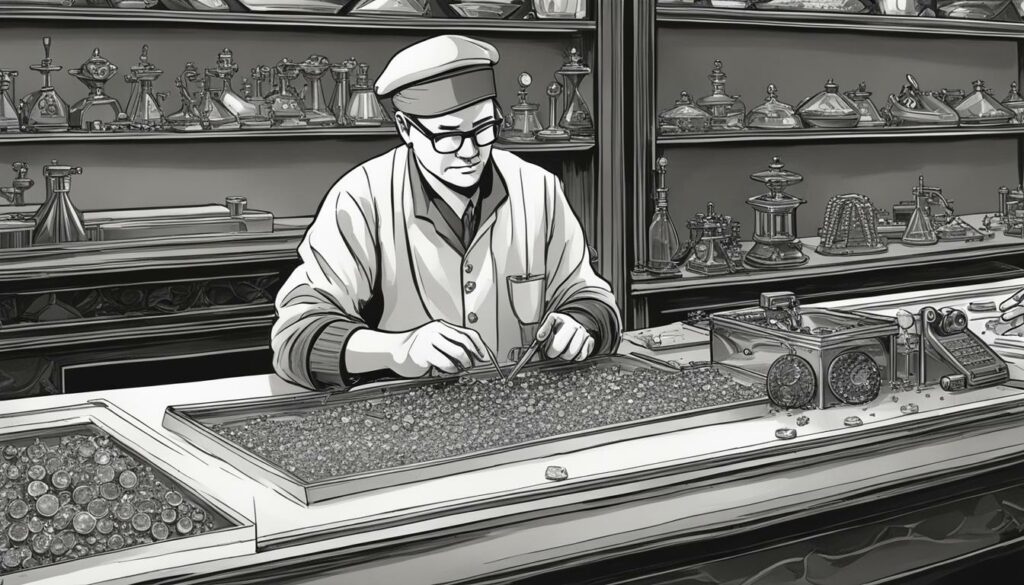
| Diamond Chips | Chipped Diamonds |
|---|---|
| Intentionally cut small | Diamonds that have been damaged or have chips on their surface |
| Used as accent stones in jewelry | Require repair or restoration to remove the damage |
| Enhance overall design and sparkle | Restore the diamond’s appearance |
The Common Misconception of Chipped Diamonds
Chipped diamonds can be surprising to some people, as diamonds are known for their hardness and durability. However, it is important to note that while diamond is the hardest mineral on Earth, it is not indestructible. Chipping can occur due to accidental impact or forceful contact with hard surfaces. It is recommended to remove diamond jewelry during activities that may increase the risk of chipping, such as rigorous sports or physical exercise.
Proper care and precautions can significantly reduce the chance of chipping diamonds. By avoiding activities that may cause impact or forceful contact with hard surfaces, you can help protect your precious diamond jewelry and keep it looking its best.
“Chipped diamonds are not a reflection of their quality or value, but rather a result of their exposure to accidental impact or forceful contact with hard surfaces.”
Remember, diamonds are meant to be worn and enjoyed. With proper care and attention, you can minimize the risk of chipping and continue to appreciate the beauty and brilliance of your diamond jewelry for years to come.
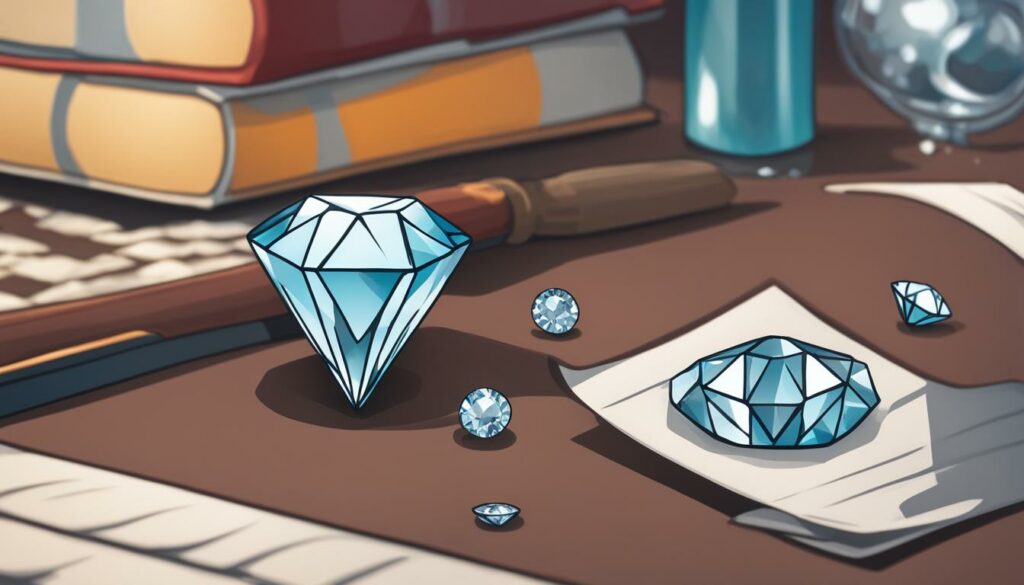
What Causes Chipped Diamonds?
| Cause | Description |
|---|---|
| Accidental Impact | Chipping can occur when a diamond is accidentally hit or bumped against a hard surface, such as a countertop or a metal object. |
| Forceful Contact | Applying excessive force to a diamond, such as gripping it tightly or squeezing it between hard objects, can lead to chipping. |
| Thin Girdle | A thin girdle, which is the outer edge of the diamond, can make the stone more susceptible to chipping, especially if it is not properly protected by the setting. |
“Understanding the causes of chipped diamonds can help you take the necessary precautions to prevent damage and preserve the beauty of your precious gemstones.”
By being mindful of these causes and taking steps to protect your diamond jewelry, you can minimize the risk of chipping and maintain the stunning appearance of your diamonds.
The Risk of Chipping During Diamond Setting
The process of setting a diamond into jewelry can sometimes pose a risk of chipping. When a jeweler sets a diamond, pressure is applied to the girdle edge of the stone to secure it in its setting. If this pressure is not carefully controlled, it can cause damage to the diamond, resulting in chips or cracks. The risk of chipping during the diamond setting process is especially higher for diamonds with thin girdle edges or internal cracks near the surface. Therefore, it is crucial to choose a skilled and experienced jeweler who understands the importance of proper techniques and tools to minimize the risk of damage.
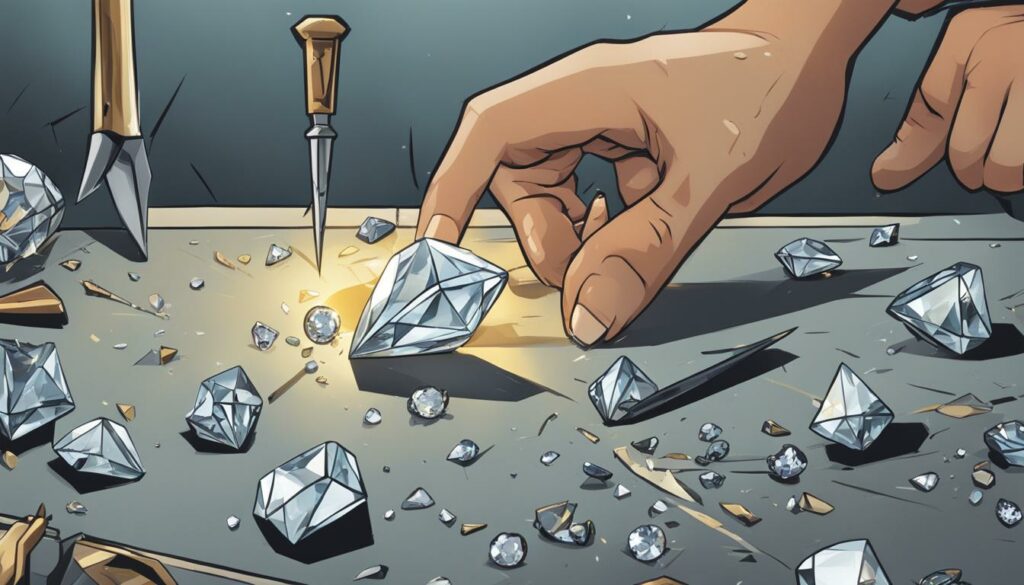
During the diamond setting process, a jeweler must balance the need for a secure setting with the need to protect the diamond from potential damage. This requires precision and attention to detail. Skilled jewelers will use specialized tools and techniques to safely set the diamond, ensuring that the pressure is evenly distributed and the risk of chipping is minimized. It is essential to choose a jeweler who has a reputation for expertise and quality craftsmanship to ensure the safety of your diamond during the setting process.
| Factors to Consider | Risk of Chipping |
|---|---|
| Thin Girdle Edges | Higher risk |
| Internal Cracks near the Surface | Higher risk |
| Skilled and Experienced Jeweler | Lower risk |
By understanding the risk of chipping during the diamond setting process and taking the necessary precautions, you can help protect your precious diamond from potential damage. When choosing a jeweler, make sure to inquire about their experience and expertise in diamond setting. Ask for recommendations or look for reviews to ensure that they have a track record of quality craftsmanship and attention to detail. By entrusting your diamond to a skilled professional, you can have peace of mind knowing that your precious stone is in safe hands.
Precautions to Reduce the Chance of Chipped Diamonds
When it comes to protecting your diamond jewelry from chipping and damage, there are a few simple precautions you can take. By being mindful of how you wear and care for your diamonds, you can significantly reduce the risk of chips and keep your precious gems looking their best for years to come.
1. Avoid Activities with Potential Impact
To minimize the chance of chipped diamonds, it’s important to avoid activities that involve rigorous sports, exercise, rock climbing, gardening, and cleaning. These activities can expose your diamonds to impact or forceful contact with hard surfaces, increasing the risk of damage. It’s best to remove your diamond jewelry before engaging in these activities or to wear protective gloves when necessary.
2. Proper Storage and Travel
When you’re not wearing your diamond jewelry, make sure to store it properly to prevent any accidental damage. Use a jewelry box with individual compartments or soft fabric pouches to keep each piece separate and secure. When traveling with your diamonds, consider using a padded travel case or carrying them in a jewelry roll to protect them from any bumps or knocks.
3. Regular Inspections and Maintenance
Regularly inspect your diamond jewelry for any signs of damage or wear. Look for chips, scratches, or loose stones, and if you notice any issues, take your jewelry to a trusted jeweler for professional inspection and maintenance. They can address any concerns, make necessary repairs, and provide guidance on how to care for your diamonds to prevent future damage.
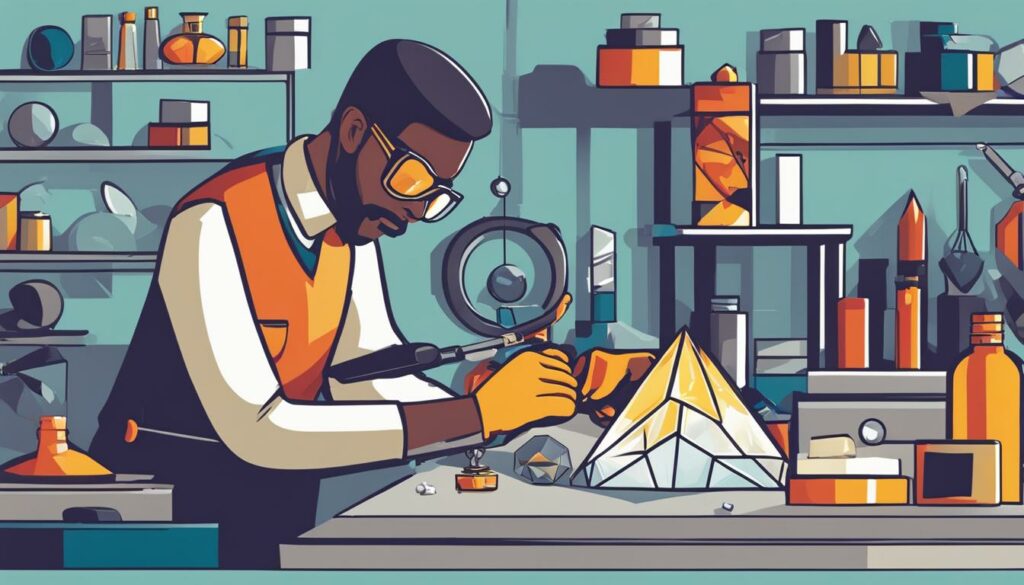
By following these precautions, you can greatly reduce the chance of chipped diamonds and keep your jewelry looking as beautiful as the day you first received it. Remember to always handle your diamonds with care, avoiding situations that may cause impact or forceful contact. Regular inspections and maintenance will help ensure the longevity and brilliance of your precious gems for generations to come.
The Importance of Jewelry Insurance for Chipped Diamonds
When it comes to protecting your valuable chipped diamonds and other precious jewelry, having proper jewelry insurance is of utmost importance. Insurance policies should cover various scenarios, including theft, fire, and accidental damage, such as chipped diamonds. However, it is essential to review the guidelines and coverage provided by your homeowner’s insurance policy, as it may offer limited protection for jewelry. Adding additional jewelry insurance can ensure full replacement coverage for your cherished pieces.
Jewelry insurance policies offered in-store may not always provide adequate coverage and can be quite costly. Therefore, it is recommended to carefully review and compare different insurance options to find a policy that suits your needs. Regularly updating jewelry appraisals is also crucial to ensure accurate coverage that reflects the current value of your chipped diamonds and other jewelry.
Investing in proper jewelry insurance gives you peace of mind, knowing that your chipped diamonds are protected against unforeseen circumstances. In the unfortunate event of damage or loss, adequate coverage can provide financial assistance and help you replace or repair your precious pieces. Remember, the sentimental value and emotional attachment associated with chipped diamonds make them irreplaceable, so protecting them with reliable insurance coverage is a wise decision.
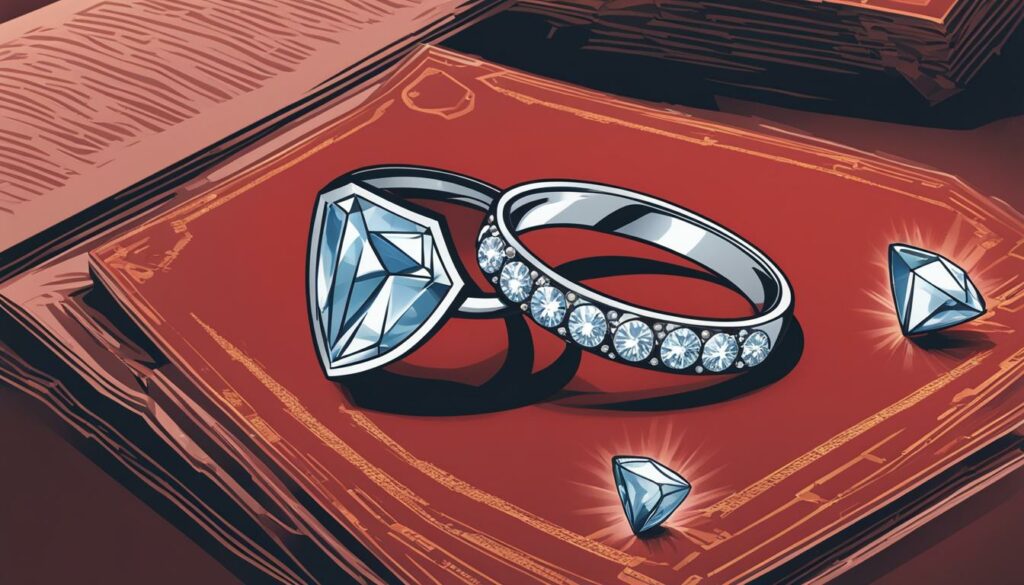
The Benefits of Jewelry Insurance for Chipped Diamonds
Here are some key benefits of having jewelry insurance for your chipped diamonds:
- Financial protection: Jewelry insurance provides coverage for chipped diamonds and helps offset the cost of repair or replacement, ensuring you don’t bear the entire financial burden.
- Peace of mind: Knowing that your chipped diamonds are protected by insurance gives you peace of mind and allows you to enjoy wearing your precious pieces without worry.
- Flexible coverage options: Jewelry insurance policies can be tailored to meet your specific needs, offering different coverage options based on the value and sentimental importance of your chipped diamonds.
- Expert support: In the event of damage or loss, reputable jewelry insurance providers offer expert assistance to help you navigate the claims process and ensure a smooth resolution.
By obtaining jewelry insurance that specifically covers chipped diamonds, you can safeguard your cherished pieces and preserve their value for generations to come. Remember to thoroughly research different insurance providers, compare coverage options, and regularly review your policy to ensure your chipped diamonds are adequately protected.
Why Replacing a Chipped Diamond Might Make Sense
When it comes to repairing a chipped diamond, sometimes replacing it with a new one can be the more practical option. Major recuts or repairs can often come with a high price tag, making it economically unviable. If the chip or damage to the diamond is significant, the cost of repair may outweigh the value of the stone itself.
Additionally, it’s important to consider the potential loss in clarity or appeal of the diamond after repair. Depending on the extent of the damage, a repaired diamond may not regain its original luster and brilliance. In such cases, replacing the chipped diamond with a new one can provide a fresh start and a stone that is free of any damage or imperfections.
Ultimately, the decision to replace a chipped diamond should be based on a combination of factors, including the sentimental value attached to the stone, the cost of repair, and the potential loss in clarity or appeal. By carefully weighing these factors, you can make an informed choice that best suits your individual circumstances.
Table: Pros and Cons of Replacing a Chipped Diamond
| Pros | Cons |
|---|---|
| Obtain a new diamond free of any damage or imperfections | Higher cost compared to repair |
| Regain the original luster and brilliance of a new diamond | Potential loss in sentimental value of the original diamond |
| No risk of further damage or imperfections | Potential loss in carat weight |
Recutting a Diamond for Improved Clarity and Beauty
When a diamond has extensive feathers, cavities, or knots that affect its appearance, recutting can be a viable option to enhance its clarity and overall beauty. Recutting involves removing or reshaping parts of the diamond to improve its quality and visual appeal. However, it is important to approach this process with caution as valuable carat weight may be lost in the recutting process.
Recutting a diamond can transform a dull or poorly cut stone into one with superb optics. By removing internal flaws or imperfections, recutting can significantly improve the diamond’s clarity, making it more visually striking. It is recommended to consult with a professional diamond cutter to determine the best course of action for a specific diamond.
While recutting can enhance a diamond’s beauty, it is important to carefully consider the potential loss of carat weight. Major recuts may result in a reduction in size, which can affect the value of the diamond. Therefore, the decision to recut a diamond should be based on an assessment of its current condition, the desired outcome, and the personal preferences of the owner.
| Pros of Recutting a Diamond | Cons of Recutting a Diamond |
|---|---|
|
|
“Recutting a diamond can truly breathe new life into a stone. By carefully assessing its current condition and working with a skilled diamond cutter, it is possible to enhance its clarity and beauty. However, it is important to consider the potential loss of carat weight and the impact it may have on the diamond’s value. Ultimately, the decision to recut a diamond should be based on a combination of aesthetic preferences and informed expertise.”
Personal Preferences and Subjective Beauty in Repairing Chipped Diamonds
When it comes to repairing chipped diamonds, personal preferences and subjective beauty play a significant role in the decision-making process. While technical factors such as size and carat weight are important, the emotional attachment and sentimental value of the diamond can outweigh material considerations.
Every diamond has a unique story, and the sentiment attached to it adds an intangible value that cannot be measured in numbers. The decision to repair a chipped diamond is not just about restoring its physical appearance; it is about preserving its meaning and heritage. When a diamond holds sentimental value, repairing or recutting it becomes a deeply meaningful choice.
Beauty, too, is subjective. While certain technical aspects like clarity and cut are crucial in determining a diamond’s visual appeal, individual preferences can diverge. Some may favor a diamond with a unique character and imperfections, seeing them as a testament to its natural origin and journey. Others may prefer a flawlessly polished diamond that dazzles with its brilliance. The decision to repair a chipped diamond should take into account how the owner envisions its aesthetic beauty.
Ultimately, the value of a chipped diamond goes beyond its material worth. It encompasses the emotions, memories, and stories associated with it. Repairing a chipped diamond can not only restore its physical integrity but also honor its sentimental value, allowing it to continue being cherished for generations to come.
Conclusion
After considering various factors such as size, sentimental value, insurance coverage, and cost, it’s clear that repairing a chipped diamond requires careful thought and decision-making. Repolishing and minor recutting can effectively restore the beauty of a damaged diamond, while major recuts may be necessary for more significant damage. The choice between repairing or replacing a chipped diamond ultimately depends on the value and sentiment attached to it.
Personal preferences and subjective beauty also come into play when making this decision. The emotional attachment and the story behind a diamond can outweigh material considerations. Therefore, when sentimental value is strong, repairing a chipped diamond to preserve its meaning and heritage can be a deeply meaningful choice.
I highly recommend consulting with experts and taking the time to assess all available options. By doing so, you can make an informed decision that aligns with your personal preferences and ensures the long-term preservation of your precious diamond.
FAQ
Can a chipped diamond be repaired?
Yes, a chipped diamond can be repaired through processes such as repolishing and minor recutting. The extent of the damage and the value of the diamond should be considered when deciding on the best repair option.
What is repolishing?
Repolishing is a process that removes surface scratches from a diamond, restoring its mirror finish. It is a suitable option for minor damage and has minimal impact on the carat weight of the diamond.
What is minor recutting?
Minor recutting involves removing a small amount of material to fix a chip in the diamond. This process can restore the clarity and visual appeal of the diamond. However, there may be a slight loss in carat weight.
Should sentimental value be considered when repairing a chipped diamond?
Yes, sentimental value should be taken into account when deciding whether to repair or replace a chipped diamond. If the diamond carries emotional significance, preserving its value through repair may be the preferred option.
Will insurance cover the repair of a chipped diamond?
Insurance coverage for chipped diamonds varies, so it is important to review your policy. Some policies may offer coverage for repair or replacement in case of damage. It is advisable to check the guidelines regarding diamond chips and other types of damage.
What is the value of repairing a chipped diamond?
Repairing a chipped diamond can preserve its value and allow it to be worn with confidence. The value of a diamond is not only determined by its material worth but also by the sentimental value and meaning we attach to it.
What is the difference between diamond chips and chipped diamonds?
Diamond chips refer to small diamonds used as accent stones in jewelry, while chipped diamonds are diamonds that have been damaged or have chips on their surface. Repairing diamond chips is generally not necessary, while chipped diamonds require repair or restoration.
How do diamonds chip?
Diamonds can chip due to accidental impact or forceful contact with hard surfaces. While diamonds are known for their hardness, they are not invincible. Thin girdle edges or internal cracks near the surface of the diamond can also increase the risk of chipping.
Are there precautions to reduce the chance of chipped diamonds?
Yes, it is recommended to remove diamond jewelry during activities such as rigorous sports, exercise, rock climbing, gardening, and cleaning that may increase the risk of chipping. Avoiding impact or forceful contact with hard surfaces can help prevent chipped diamonds.
How important is jewelry insurance for chipped diamonds?
Having proper jewelry insurance is crucial for protecting chipped diamonds and other valuable jewelry. Insurance policies should cover theft, fire, and accidental damage, including chipped diamonds. Regularly reviewing jewelry appraisals ensures accurate coverage.
When is it better to replace a chipped diamond instead of repairing it?
If the chip or damage is significant and the cost of repair is high, it may be more cost-effective to replace the diamond with a new one. This decision should consider the sentimental value, cost of repair, and potential loss in clarity or appeal of the diamond.
What is recutting a diamond?
Recutting a diamond involves removing material to improve its clarity and beauty. If a diamond has extensive feathers, cavities, or knots that affect its appearance, recutting can enhance its overall quality. However, major recuts may result in a loss of valuable carat weight.
How important are personal preferences in repairing chipped diamonds?
Personal preferences and subjective beauty play a significant role in deciding whether to repair a chipped diamond. While material considerations are important, the emotional attachment and sentimental value of the diamond can outweigh them in some cases.
Source Links
- https://niceice.com/chipped-diamonds-cracks-fractures-bruise-scratch/
- https://www.whiteflash.com/diamond-education/repairing-scratched-or-chipped-diamonds/
- https://beyond4cs.com/cut/repolishing-damaged-diamonds/is-it-worth-it/

Hey lovely readers! My name is Chantal and I am obsessed with everything accessory and jewelry. My husband (and best friend) John and I, have been writing content for this blog for over 4 years now started the RTP store with over 4000 curated accessories and jewelry. We are traveling around the world to find the latest products, negotiate the best prices and find the best quality for our readers. We have managed to make our passion for feeling and looking good into our work. We are always open to new product suggestion, improvements or feedback. If you would like to chitchat with me, email me here!
